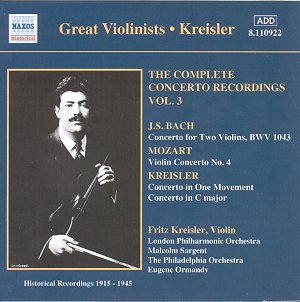GREAT VIOLINISTS - KREISLER
The Complete Concerto Recordings (volume 3)
Various orchestras and conductors
Bach Double Concerto in D
minor
Mozart Violin Concerto no 4 in
G
Paganini/Kreisler Concerto in D in one
movement
Kreisler (after Vivaldi) Concerto in
C
 NAXOS Historical Recordings
8.110922 [70.
07]
NAXOS Historical Recordings
8.110922 [70.
07]
Crotchet

On several counts, this is a recording of exceptional interest. It serves
as a vivid reminder of Kreisler's incomparable artistry - his relaxed virtuosity,
rich tonal palette and effortless bowing technique. His frequent indulgence
in portamento also reminds us of changing fashions in violin-playing.
The Bach is an acoustic recording dating from 1915 in which Kreisler is joined
by Efrem Zimbalist (nicely-contrasted in style) and an accompaniment reduced
to a string quartet. This remastering is remarkably vivid: thematic lines
are clear throughout, the balance is excellent and though eyebrows would
now be raised at the excessive rallentando at the close of the first movement
and a largo which is definitely tanto, this is a performance to savour despite
its venerable age.
The Mozart, recorded in 1939, is notable as much for Kreisler's elegant cadenzas
as for his consistently silken tone. In passing - he accompaniment which
the youthful Sargent drew from the LSO is characterised by a suppleness which
was later to desert him.
Paganini's violin concertos contain bright ideas but a poverty of symphonic
development, so Kreisler's imaginative reworking of the first movement of
the D major concerto puts the composer in a favourable light - it does not
outstay its welcome as is the case with the original. The highlight here
is a stunning cadenza. But, as Tully Potter points out in an informative
accompanying booklet, this was an early RCA Victor concerto recording, and
the company's inexperience in the field brought an unexpected bonus. No
'spotlight-mike' is used for the soloist, so the result is an experience
much more faithful to concert hall conditions than is usually the case nowadays.
This recording was made in 1936, shortly after Ormandy became conductor of
the Philadelphia Orchestra and signs of the opulent sound for which he made
it famous are already apparent.
The Concerto after Vivaldi (1945) is one of Kreisler's pseudo-baroque confections
- its second movement at any rate sounds vaguely authentic.
For the technically-minded the provenance of this recordings is provided
in detail
Adrian Smith
Performance

Sound


